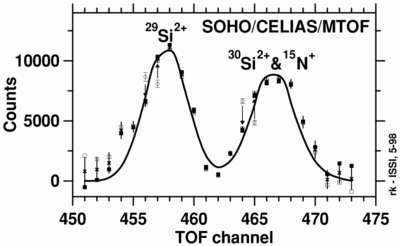Image Details

Caption: Fig. 2.
The fitted peak shape functions shown in Fig. 1 are subtracted from the measured counts, thus leaving the ﹩^{29}﹩Si﹩^{2+}﹩ peak and the ﹩^{30}﹩Si﹩^{2+}﹩ and ﹩^{15}﹩N﹩^{+}﹩ peak. The different data symbols represent method M1 (filled squares), method M2 (open squares), and the average of methods M1 and M2 (crosses). The uncertainty in the difference spectrum is due to the purely statistical counting error that arises from the full count numbers, including the background, as well as the systematic uncertainty determined from the deviations in the fitted parameters of methods M1 and M2 (Table 1). In channels 456–457 and 464–465, the ADC effect is visible. The signal has been corrected by assuming that the sum of counts in two neighboring channels remains essentially conserved; the uncorrected signal in these channels is shown with open circles. Only the largest ADC effects with ﹩n_{0}=3﹩, 4 have been corrected. In fact, each pair of channels shows the effect to some extent. The fit assumes the same width for the ﹩^{29}﹩Si﹩^{2+}﹩ peak and the ﹩^{30}﹩Si﹩^{2+}﹩ and ﹩^{15}﹩N﹩^{+}﹩ peak as for the ﹩^{28}﹩Si﹩^{2+}﹩ and ﹩^{14}﹩N﹩^{+}﹩ peak and the ﹩^{16}﹩O﹩^{+}﹩ peak.
Copyright and Terms & Conditions
© 1998. The American Astronomical Society. All rights reserved. Printed in U.S.A.




